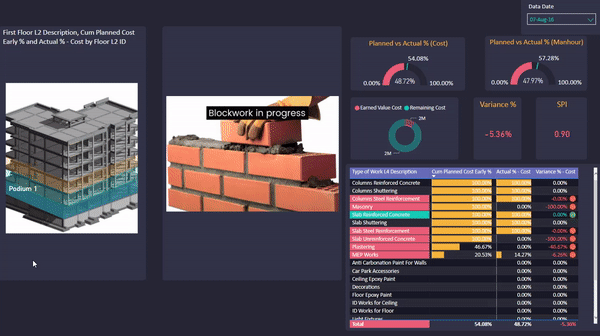While projects are getting only more complex, many planning engineers still prepare static progress reports. They spend most of their time performing calculations and working with many excel sheets. The outcome is an ineffective static report, whereas the value is not proportionate to the amount of time and effort that is spent to deliver this outcome.
The disadvantages of static reports
A static report is like a template that you fill out after each progress update cycle. This can include “pre-defined” key indicators, tables and visualizations. As a result, both the planning engineer and the reviewer will have limited ability in making decisions because their analysis cannot go beyond what they see in the report.
The advantages of interactive reports
On the other hand, if you have an interactive project control model, everyone has the potential to analyze other areas which they wouldn’t have thought of before. They can dig deeper, identify more causes of delays or review the progress status on any data date with a click of a button, as necessary. In addition, they can review the planned work for other areas and have effective preparation in advance. These questions and the corresponding answers change every week based on any improvements and shortfalls that you have in your project. In other words, your current progress status dictates the type and level of analysis that you wish to perform. For example, you might observe a delay that occurred in one area of the project and decide to prepare a breakdown analysis or trend performance report to identify the root causes of the delay. This type of analysis can’t be achieved with static reports/templates.
The interactive report in practice
But how can we do that? Well, Power BI helps planning engineers perform interactive analysis with a click of a button. Just to give you an idea, the below image illustrates an example of how this looks like. You can click on any area and instantly present the corresponding status. You can also navigate among all the different report sections with a click of a button.


However, for some reason, you might need to produce static reports. This might happen because it is stipulated in the Contract or requested by the Employer. If you decided to produce such reports, at least don’t spend any time doing so (Power BI allows you to do that). Your time and effort should be directed towards high-impact valuable tasks that help the project move forward. Moreover, a comprehensive interactive report can be communicated via a web link. Anyone who has access to this link can perform an interactive analysis across all report areas. The interesting part is that the reviewers don’t have to install Power BI on their computers to review the report. To give you an idea of how this looks like, you can access an interactive report at the below link.
Click here to access the interactive reports
Impress Stakeholders
When key decision-makers review the static progress reports, they will often have follow-up questions to understand how the issue can be dealt with. In return, the planning engineer will promise to prepare and provide the answers later. Does this scenario sound familiar? If so, you will probably agree with me that this is a nightmare and also ineffective.
On the other hand, imagine that you instantly provide accurate answers within seconds without leaving the meeting. All you need is a laptop (or even a mobile phone). Moreover, you will be able to present the project progress like a pro. You can analyze any area in the project and recall the progress status on any data date with a click of a button. Not only will you impress the stakeholders with supreme skills but also scarce ones because very few planning engineers know how to use Power BI effectively. The meeting participants will be impressed by your beautiful dashboards, speed of analysis, convenience, reliability, practicality, valuable contributions, efficiency, clarity and professionalism. This is Project Control.
The red pill
Not only are planning engineers conditioned to focus only on progress reports but also the static ones and I am really disappointed with that. As a result, they don’t add the expected value to their projects which are often completed late and over budget. We need to shift our mindset on progress reporting, interactive dashboards, workflows and what an effective contribution to the project’s success means. This is a tough red pill to swallow but this is the reality. You need to open your eyes and see things for what they truly are. You need to unplug from the false beliefs we currently have in project control and change your tools and methods to become more effective and stand out from the competition.
Regards,
Osama Saad, MBA, PMP, PSP, PMI-SP
Learn More!










